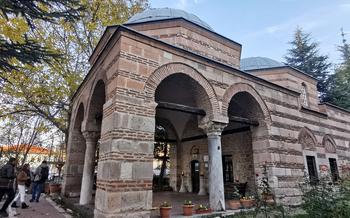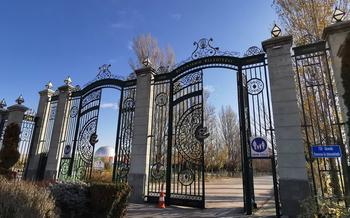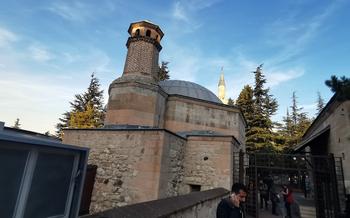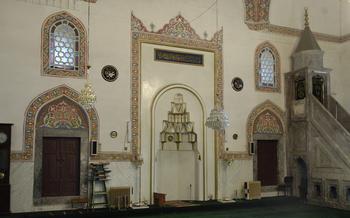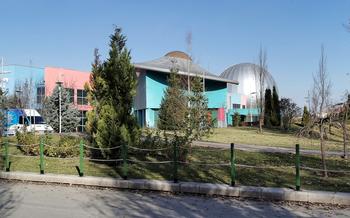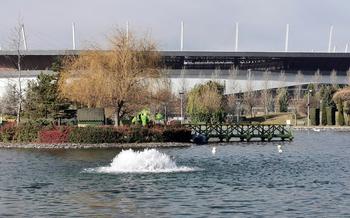
Deliklitaş Underground Cistern
- History of the Deliklitaş Underground Cistern
- Location and Accessibility: Unveiling the Deliklitaş Underground Cistern
- Architectural Features
- Water Source and Storage Capacity:
- Exploration and Restoration Efforts
- Significance in Urban Planning
- Visitor Experience and Tours
- Legends and Folklore
- Nearby Attractions
- Photography and Videography: Capturing the Essence of Deliklitaş
- Conservation and Sustainability
- Local Culture and Cuisine: A Culinary Journey Through History
- Accommodation Options
- Local Festivals and Events: Unveiling Eskişehir's Cultural Treasures
- Insider Tip: Unveiling Hidden Treasures
History of the Deliklitaş Underground Cistern
The Deliklitaş Underground Cistern, an awe-inspiring testament to Ottoman engineering prowess, was built in the 17th century during the reign of Sultan Murad IV. This subterranean masterpiece played a crucial role in the city's water supply system, serving as a vital reservoir for the growing population of Eskişehir. The cistern's design evolved over time, adapting to changing needs and advancements in construction techniques. Initially conceived as a simple storage facility, it was later expanded and reinforced with additional chambers and support structures. These modifications ensured the cistern's longevity and resilience, enabling it to withstand the test of time and continue serving its purpose for centuries to come.
Location and Accessibility: Unveiling the Deliklitaş Underground Cistern
Exact Location: The Deliklitaş Underground Cistern is situated in the heart of Eskişehir, Turkey, beneath the vibrant streets of the city's old town. It lies concealed under the ground, waiting to be discovered by curious travelers.
Public Transportation: To reach the cistern, visitors can conveniently hop on the city's tram system. The nearest stop is called "Kurşunlu," which is just a short walk from the cistern's entrance. The tram offers a scenic and affordable way to navigate Eskişehir's charming streets.
Walking Distance from Nearby Attractions: The Deliklitaş Underground Cistern is strategically located within easy walking distance of several other notable attractions in Eskişehir. Visitors can explore the historic Porsuk River, stroll through the enchanting Odunpazarı district, or admire the architectural wonders of the Kurşunlu Mosque, all within a short walk from the cistern.
Accessibility for Differently-Abled Visitors: The cistern's management is committed to ensuring that all visitors, regardless of their abilities, can enjoy the wonders of this hidden treasure. The site features accessible pathways and ramps, allowing wheelchair users and visitors with limited mobility to navigate the cistern with ease.
Architectural Features
The Deliklitaş Underground Cistern showcases remarkable architectural prowess and engineering ingenuity. Constructed using locally sourced stone and bricks, the cistern features a series of interconnected chambers supported by sturdy pillars and arches. The use of these structural elements creates a sense of grandeur and spaciousness, allowing for the efficient storage of vast quantities of water.
The cistern's vaulted ceilings are particularly noteworthy, demonstrating the advanced construction techniques employed during its construction. These vaults not only provide structural stability but also contribute to the cistern's impressive acoustics, enhancing the overall ambiance of the space.
Additionally, the cistern boasts intricate carvings and decorative details, showcasing the artistic sensibilities of its builders. These embellishments, often featuring geometric patterns and stylized motifs, add a touch of elegance to the cistern's otherwise utilitarian design.
Water Source and Storage Capacity:
The Deliklitaş Underground Cistern's primary water source was an underground river that flowed beneath the city of Eskişehir. This river was diverted into the cistern through a series of channels and tunnels, ensuring a continuous supply of fresh water. The cistern's remarkable engineering allowed water to be collected and stored during the rainy season to sustain the city during dry spells and droughts.
The estimated storage capacity of the Deliklitaş Underground Cistern is approximately 10,000 cubic meters, which is equivalent to 10 million liters of water. This vast capacity played a crucial role in meeting the water demands of Eskişehir's growing population and various industries.
Currently, the water level in the cistern is significantly lower due to several factors, including reduced rainfall, changing water table levels, and increased water consumption in the city. Despite these challenges, the cistern's impressive structure and historical significance continue to captivate visitors and serve as a testament to the ingenuity and foresight of its ancient builders.
Exploration and Restoration Efforts
The rediscovery of the Deliklitaş Underground Cistern in the 19th century sparked great interest among historians and archaeologists. However, it was not until the early 20th century that comprehensive exploration and excavation efforts began. These endeavors faced significant challenges due to the cistern's dilapidated condition and the accumulation of debris and sediment over centuries.
Excavation teams meticulously removed layers of soil and rubble, revealing the cistern's intricate architecture and impressive dimensions. The process required careful planning and coordination to ensure the safety of the structure and the preservation of any artifacts that might be uncovered.
As the exploration progressed, restoration projects were undertaken to stabilize the cistern's structure and prevent further deterioration. These efforts involved reinforcing the walls, repairing damaged arches, and implementing drainage systems to manage groundwater and prevent flooding.
The restoration process also focused on preserving the cistern's original features, such as the stone carvings, niches, and inscriptions that adorned its interior. Skilled artisans and conservators worked diligently to restore these elements to their former glory, ensuring that the cistern's historical significance and aesthetic beauty were preserved for future generations.
Ongoing efforts to maintain the integrity of the Deliklitaş Underground Cistern include regular inspections, monitoring of groundwater levels, and implementation of preventive measures to protect the structure from environmental factors and potential damage. These efforts are crucial to ensuring the cistern's continued existence as a testament to the ingenuity and engineering prowess of its ancient builders.
Significance in Urban Planning
The Deliklitaş Underground Cistern played a crucial role in managing Eskişehir's water resources and influenced the city's urban planning and infrastructure development. The Romans, masters of hydraulic engineering, built the cistern to meet the water demands of their growing city. The cistern's capacity and strategic location enabled efficient water distribution, ensuring a reliable water supply for various urban activities, including domestic use, irrigation, and public fountains.
The cistern's significance extends beyond its utilitarian purpose; it also served as a testament to the city's engineering prowess. The construction of such an impressive subterranean structure showcased the Romans' advanced knowledge of hydraulics and their commitment to providing a sustainable water supply for their citizens. Its strategic placement within the urban fabric demonstrates the city's foresight and dedication to long-term planning.
Comparisons can be drawn between the Deliklitaş Underground Cistern and other notable underground cisterns in the region, such as the Basilica Cistern in Istanbul or the Aljibe in Córdoba, Spain. These structures share remarkable similarities in terms of their construction techniques, architectural features, and historical significance. Studying and comparing these cisterns offers valuable insights into the urban planning strategies and water management systems of ancient civilizations.
The Deliklitaş Underground Cistern stands as a testament to the ingenuity and foresight of the Romans. Its lessons in hydraulic engineering, urban planning, and sustainable resource management continue to inspire modern urban development practices, serving as a valuable resource for urban planners and architects worldwide.
Visitor Experience and Tours
The Deliklitaş Underground Cistern offers a unique and captivating experience for visitors, inviting them to step back in time and explore the hidden depths of Eskişehir's history. Guided tours are available for those who wish to delve deeper into the cistern's significance, with knowledgeable guides sharing stories and insights that bring the cistern's past to life.
For those who prefer to wander at their own pace, self-guided exploration is also possible. Visitors can follow the designated paths, admiring the cistern's architectural marvels and imagining the lives of those who once relied on this vital water source.
The tour highlights include the cistern's impressive arched ceilings, supported by rows of sturdy pillars. Visitors can marvel at the intricate engineering techniques employed to construct such a vast underground space, ensuring its stability over centuries. The cistern's cool and humid atmosphere adds to the enchanting experience, transporting visitors to a bygone era.
The duration of the tour typically ranges from 30 to 45 minutes, allowing visitors ample time to explore the cistern's various sections and capture stunning photographs. It is recommended to set aside at least an hour for the entire experience, including time to wander, take photos, and soak in the cistern's unique atmosphere.
To enhance your visit, consider arriving early to avoid crowds and capture the cistern's beauty in the morning light. Comfortable footwear is recommended as the cistern's floor can be uneven in places. Flash photography is not permitted, as it can damage the cistern's delicate features. Instead, opt for natural light or a tripod to capture the best shots.
Legends and Folklore
Throughout history, the Deliklitaş Underground Cistern has captivated the imagination of locals and visitors alike, inspiring a rich tapestry of myths and legends. One of the most popular tales recounts the existence of a secret passage leading to a hidden treasure chamber filled with gold and jewels. Folklore suggests that the cistern's name itself, which translates to "pierced stone," alludes to a secret entrance concealed beneath a stone slab.
Another legend tells the story of a beautiful princess who was imprisoned within the cistern's dark depths. According to the tale, she was rescued by a brave knight who followed a mysterious light that guided him through the underground labyrinth. Visitors to the cistern can still glimpse the faint glimmer of this ethereal light, said to be the spirit of the princess, guiding lost souls through the cistern's intricate corridors.
These legends have become an integral part of the cistern's allure, adding an air of mystery and intrigue to its already captivating history. They serve as a reminder of the enduring power of storytelling and the human fascination with the unknown.
Nearby Attractions
The Deliklitaş Underground Cistern is not just a standalone attraction; it is part of a vibrant tapestry of historical and cultural landmarks that make Eskişehir a captivating destination. A short stroll from the cistern, visitors can immerse themselves in the city's rich past at the Eskişehir Archaeological Museum, which houses an impressive collection of artifacts from various eras. The müze houses a vast array of artifacts, including pottery, jewelry, sculptures, and tools, offering a glimpse into the region's diverse cultural heritage.
For those seeking a more immersive experience, the Odunpazarı district, just a stone's throw away from the cistern, invites visitors to step back in time. This charming neighborhood, with its cobblestone streets, traditional Ottoman houses, and quaint shops, provides a glimpse into the city's architectural and cultural legacy. Here, visitors can savor authentic Turkish cuisine at local restaurants, browse for unique souvenirs and handicrafts, and soak in the vibrant atmosphere of a bygone era.
To explore the city's natural beauty, visitors can head to the Porsuk River, which meanders through the heart of Eskişehir. Along its banks, visitors can enjoy scenic walks, admire the picturesque bridges, and relax in serene parks. The riverfront is also home to several cafes and restaurants, offering a delightful setting to unwind while enjoying a refreshing beverage or a delicious meal.
By combining a visit to the Deliklitaş Underground Cistern with these nearby attractions, travelers can create a comprehensive and enriching itinerary that offers a multifaceted exploration of Eskişehir's history, culture, and natural beauty.
Photography and Videography: Capturing the Essence of Deliklitaş
Permitted Areas and Guidelines: Photography and videography are permitted within designated areas of the Deliklitaş Underground Cistern. Visitors are allowed to capture the cistern's beauty through their lenses, subject to certain guidelines. Tripods and flash photography are generally allowed, but visitors should be mindful of other tourists and avoid obstructing their experience.
Best Angles and Lighting: To capture stunning images, photographers should experiment with different angles and lighting conditions. The cistern's symmetrical arches, intricate pillars, and vaulted ceilings offer a variety of perspectives. The best lighting conditions are usually found during the early morning or late afternoon hours when the natural light illuminates the cistern's interior in a dramatic way.
Creating Visually Appealing Content: To create visually appealing content, photographers and videographers should focus on capturing the cistern's grandeur and unique features. Wide-angle lenses are ideal for capturing the scale of the cistern, while close-ups can highlight the intricate details of the architecture. Experimenting with different shutter speeds can convey a sense of movement and enhance the dynamic nature of the water.
Tips for Memorable Shots: - Position yourself in the center of the cistern to capture the symmetry of the arches and pillars. - Use a low angle to create a sense of grandeur and emphasize the height of the cistern. - Experiment with reflections in the water to add depth and interest to your shots. - Capture the play of light and shadow on the cistern's walls and pillars for dramatic effects.
Conservation and Sustainability
Preserving the Deliklitaş Underground Cistern for future generations is a top priority for local authorities and conservationists. Environmental and sustainability initiatives are crucial in maintaining the structural integrity and historical value of the cistern. Challenges arise in balancing the need for preservation with the desire to make the site accessible to visitors.
Conservation efforts include regular maintenance, monitoring of water levels, and restoration projects to address any damage or deterioration. Sustainable practices, such as energy-efficient lighting and responsible waste management, are implemented to minimize the environmental impact of tourism.
Visitors play a vital role in promoting responsible tourism by following guidelines, respecting the site's history, and avoiding activities that could harm the cistern's delicate ecosystem. By adhering to sustainable practices, travelers can help protect this valuable heritage for years to come.
Local Culture and Cuisine: A Culinary Journey Through History
The Deliklitaş Underground Cistern is an integral part of Eskişehir's identity and heritage, reflecting the city's rich history and cultural traditions. Visitors can delve deeper into the local culture by exploring the culinary delights inspired by this remarkable site.
Traditional dishes in Eskişehir often draw inspiration from the cistern's significance as a water source. One must-try dish is "Su Böreği" (water pastry), a flaky pastry filled with savory cheese and herbs, symbolizing the abundance of water. "Kelle Paça" (sheep's head and trotters soup) is another local delicacy, believed to have healing properties and often enjoyed in winter.
To experience authentic Turkish cuisine, visitors can venture into the narrow streets and alleys near the cistern. There, they will find cozy restaurants and cafes offering a delectable array of dishes. "Mantı" (Turkish ravioli) and "Köfte" (meatballs) are popular choices, while vegetarians can indulge in "Gözleme" (stuffed flatbread) or "Mercimek Çorbası" (lentil soup).
For those seeking a unique dining experience, a visit to the "Tarihi Odunpazarı Çarşısı" (Odunpazarı Historical Market) is a must. This charming market, located a short walk from the cistern, offers an array of traditional Turkish delights, including freshly baked bread, handmade sweets, and aromatic spices.
By immersing oneself in the local cuisine, visitors can not only satisfy their taste buds but also gain a deeper understanding of Eskişehir's rich cultural heritage.
Accommodation Options
Eskişehir offers a diverse range of accommodation options to suit various preferences and budgets, ensuring a convenient and comfortable stay for visitors exploring the Deliklitaş Underground Cistern and other city attractions.
When seeking accommodations near the cistern, consider the following recommendations:
-
Convenient Location: Opt for hotels or guesthouses within walking distance of the cistern to minimize transportation hassles and maximize exploration time.
-
Amenities and Comfort: Choose accommodations that offer essential amenities like clean rooms, comfortable beds, and reliable Wi-Fi to ensure a pleasant stay.
-
Local Charm: Immerse yourself in Eskişehir's culture by staying in traditional guesthouses or boutique hotels that reflect the city's unique character.
-
Advance Booking: To secure the best deals and avoid disappointment, especially during peak tourist seasons, book your accommodations well in advance.
-
Central District: Consider staying in the old town or central district, which offers a vibrant atmosphere, easy access to attractions, and a variety of dining options.
By following these tips, you can find accommodations that not only provide a comfortable base for your exploration but also enhance your overall travel experience in Eskişehir.
Local Festivals and Events: Unveiling Eskişehir's Cultural Treasures
Eskişehir, a city brimming with history and culture, plays host to a vibrant array of festivals and events throughout the year. These celebrations offer visitors an exceptional opportunity to immerse themselves in the city's unique heritage and vibrant atmosphere.
One of the most highly anticipated events is the Eskişehir International Film Festival, which showcases a diverse selection of local and international films, attracting cinephiles from across the globe. The festival provides a platform for filmmakers to share their artistic creations and for audiences to engage in thought-provoking discussions about the art of filmmaking.
Another popular event is the Eskişehir Music Festival, a celebration of music in all its forms. The festival features a lineup of talented local and international musicians, captivating audiences with their diverse genres and styles. From traditional Turkish melodies to contemporary beats, the festival offers a musical journey that caters to every taste.
For those interested in exploring the city's rich history, the Eskişehir History and Culture Festival is a must-attend event. This festival brings to life the city's past through captivating performances, historical reenactments, and exhibitions. Visitors can delve into the stories of Eskişehir's ancient civilizations, marvel at traditional crafts, and gain a deeper understanding of the city's unique identity.
To fully immerse yourself in the local culture, be sure to attend one of the many traditional Turkish festivals held throughout the year. These festivals showcase the city's vibrant folklore, featuring colorful processions, lively music, and delicious local cuisine. Join in the festivities, learn about Turkish customs, and experience the warmth and hospitality of the local community.
Insider Tip: For an unforgettable experience, plan your trip to Eskişehir around one of these local festivals. Immerse yourself in the city's vibrant atmosphere, connect with the locals, and create memories that will last a lifetime.
Insider Tip: Unveiling Hidden Treasures
Beyond the main tourist trail, the Deliklitaş Underground Cistern holds secrets waiting to be uncovered. Venture off the beaten path to discover a hidden chamber adorned with intricate carvings and inscriptions that tell tales of the cistern's rich history. This secret chamber, once used for ceremonial purposes, offers a glimpse into the cistern's spiritual significance. For photography enthusiasts, capturing the interplay of light and shadow within this chamber at dusk creates a magical atmosphere. It's a hidden gem that rewards those who seek to explore beyond the surface, offering a unique perspective on this architectural marvel.

